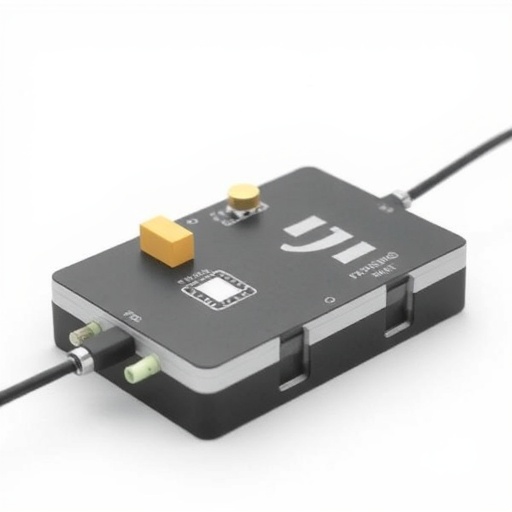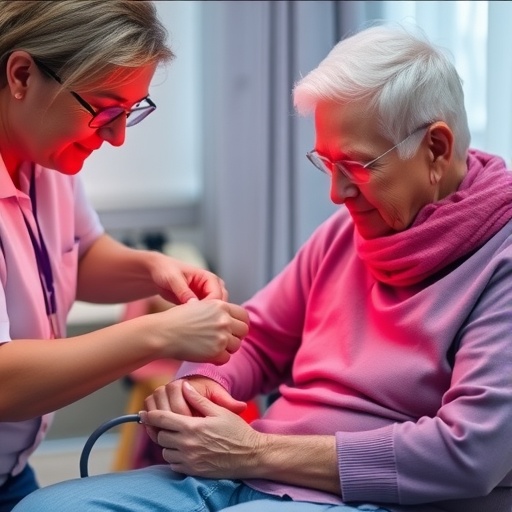In a landmark advancement poised to revolutionize the management of abdominal aortic aneurysms (AAA), a research team led by Dr. Yei Hwan Jung at Hanyang University, South Korea, has engineered a groundbreaking ultrathin, flexible sensor capable of being seamlessly integrated with stent grafts. This innovation introduces smart, real-time monitoring to the traditionally passive endovascular aneurysm repair (EVAR) devices, enabling continuous and wireless detection of dangerous blood leakage that can occur post-surgery — a complication known as endoleaks.
Abdominal aortic aneurysms are critical dilations of the aortic wall in the abdomen that threaten patient survival by risking rupture. Endovascular aneurysm repair, a minimally invasive intervention, has transformed treatment paradigms by excluding the aneurysm sac from circulation using a stent graft. However, a lingering challenge has been the silent occurrence of endoleaks, specifically Type-I endoleaks, which manifest as blood flow leaking into the aneurysm sac due to imperfect sealing at the graft attachment sites. These leaks harbor the highest risk of rupture, but their detection is hampered by the absence of specific symptoms and limitations in current diagnostic protocols.
Patients typically undergo periodic imaging-based surveillance via computed tomography angiography (CTA) or magnetic resonance imaging (MRI) to identify endoleaks. While effective, these methods are constrained by risks such as radiation exposure, cost, limited accessibility, and infrequent monitoring intervals that may delay detection. Such limitations underscore a pressing need for continuous, real-time, and minimally invasive monitoring technologies to bridge the care gap and improve patient outcomes after EVAR.
Addressing this clinical void, Dr. Jung’s team has demonstrated an ultrathin sensor fabricated with flexible materials that retain mechanical robustness to endure the dynamic biomechanical stress within the vasculature. The sensor’s design allows it to be crimped and delivered via catheter alongside the stent graft, then deployed in situ without any compromise to the structural integrity or function of the graft. Embedded directly into the stent, this sensor transforms the device from a passive scaffold into an active biosensor capable of detecting minute changes indicative of blood leakage.
The sensor operates by measuring subtle variations in fluid dynamics and pressure changes around the stent graft interface, detecting even the earliest onset of endoleak formation. Rigorous experimentation has validated the sensor’s blood compatibility, confirming that it does not induce additional leakage or thrombogenic responses. Further, long-term stability tests confirm its robust performance under constant vascular pulsations and flow dynamics, ensuring reliable operation throughout the patient’s postoperative course.
Beyond the technical rigor, the implications of this technology are profound. By providing continuous endoleak monitoring, the sensor empowers clinicians to initiate timely interventions, potentially averting catastrophic aneurysm ruptures. Such proactive management could redefine patient follow-up protocols, shifting from conventional intermittent imaging to seamless, real-time surveillance that is inherently safer, less costly, and more accessible, especially for patients in remote or underserved regions.
Moreover, the platform technology heralds a broader paradigm shift in implantable medical devices. Its flexible and biocompatible nature opens avenues for adaptation across other vascular interventions where fluid leakage poses risks. For instance, sensors could be integrated into stents treating peripheral artery disease or arteriovenous grafts employed in hemodialysis, providing critical early warning signals to enhance the longevity and safety of these procedures.
Looking ahead, Dr. Jung envisions an ecosystem of smart implants interconnected via telemedicine platforms. This futuristic scenario would enable wireless transmission of sensor data to patients’ smartphones and subsequently to their healthcare providers, facilitating continuous remote monitoring. Such connectivity promises to drastically reduce hospital visits and the burden on healthcare infrastructure while enhancing personalized medical care for the aging population and those in rural areas.
As this sensor technology advances towards clinical translation, there remain challenges to address, including large-scale manufacturing, regulatory approvals, integration with existing clinical workflows, and ensuring cybersecurity and data privacy. Nonetheless, its potential to become the new standard of care for AAA management is undeniable — heralding an era where stent grafts are no longer inert devices but intelligent systems providing life-saving insights.
This innovation not only enhances postoperative safety and outcomes but also propels medical science into a new frontier of bioelectronic medicine. The fusion of microfabrication, flexible electronics, and vascular surgery epitomizes the cross-disciplinary ingenuity required to tackle complex health issues with precision and foresight. The future of aneurysm treatment, augmented by insights from embedded sensors, looks smarter, safer, and more connected than ever before.
Such breakthroughs reinforce the vital role of engineering and material sciences in reimagining healthcare solutions. By pushing the boundaries of what implants can do, researchers like Dr. Jung and his team are transforming the way clinicians monitor and manage critical cardiovascular conditions, ultimately saving lives and improving quality of life for millions worldwide.
Subject of Research:
Not applicable
Article Title:
A wireless, implantable sensor for continuous monitoring of blood leakage after endovascular aneurysm repair
News Publication Date:
1-Oct-2025
Web References:
https://doi.org/10.1126/sciadv.ady6148
References:
DOI: 10.1126/sciadv.ady6148
Image Credits:
Yei Hwan Jung from Hanyang University
Keywords:
Medical technology, Medical equipment, Bioengineering, Biotechnology, Health and medicine, Health care
Tags: abdominal aortic aneurysm managementcontinuous endoleak detectionendovascular aneurysm repair innovationHanyang University research breakthroughsimaging-based surveillance limitationsminimally invasive surgical techniquespost-surgery blood leakage detectionreal-time monitoring in surgerystent graft integration advancementsType-I endoleaks complicationsultrathin flexible sensor technologywireless health monitoring devices





